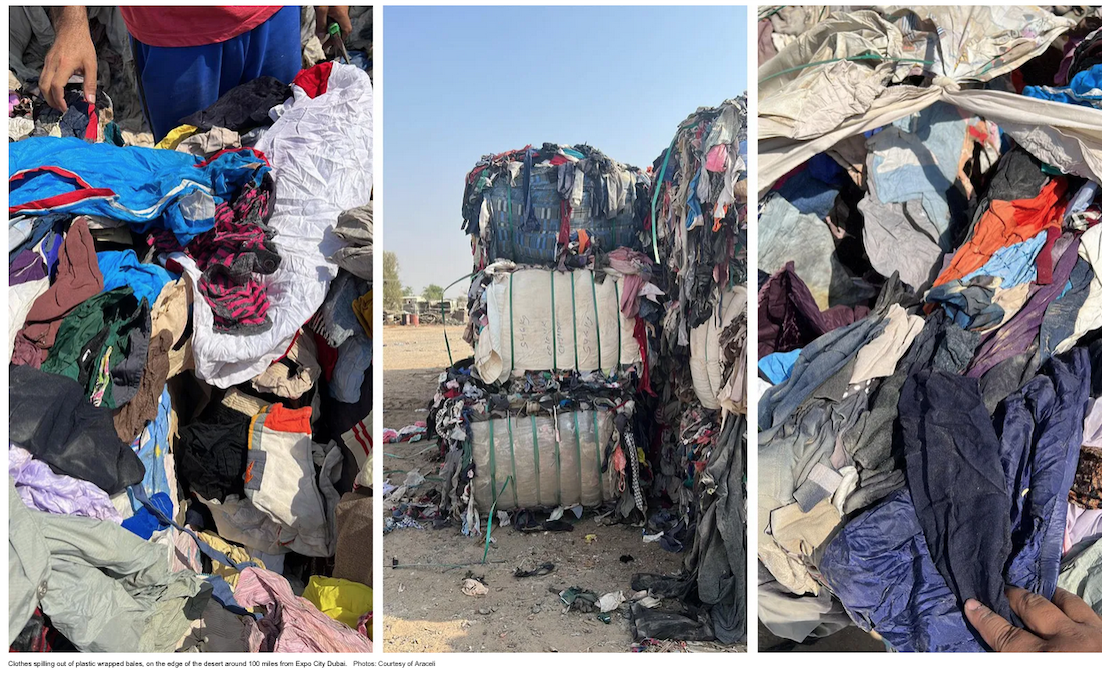
In a dusty yard on the edge of the desert around 100 miles from Expo City Dubai, the venue for COP28, 20 tonnes of textile waste is perishing, clothes spilling out of plastic wrapped bales, being whipped by the sand and bleached by the sun. Its presence underscores the challenges facing the fashion industry when it comes to collecting, sorting and recycling unwanted clothing — and the emptiness of some companies’ “zero waste to landfill” promises.
The waste came to the attention of Dubai-based sustainability expert Anita Nouri in early October, after she received a call asking for her help in tackling it. (Nouri has chosen to protect the caller’s identity to shield them from any repercussions.) The waste’s exact origins are unknown. But this isn’t unusual for a global trade that excels in transporting used or unwanted clothes from one market to another without assigning responsibility to anyone — whether brands, retailers or exporters — for what happens to them.
With no one responsible for overseeing or ensuring integrity in the management of garment and textile waste globally, there’s also no clear strategy or solution — nor funding to implement any would-be solution — for what to do with it.
The UAE is one of the world’s top importers of used clothing, according to the OEC, and there are more than 40 “multidisciplinary free zones” in the country: areas where foreign investors can have full ownership of their companies and are now known as hotspots for the importation of secondhand clothing due to financial exemptions and independent regulations. Free zones have led to problems with waste in other countries and in Chile’s Atacama Desert, some 60,000 tonnes of textile waste has accumulated — the unsellable remnants of what’s imported via the Alto Hospicio free zone.
It’s a growing problem. “Between 2000 and 2022, global fibre production has grown from 58 million tonnes to 116 million tonnes, so we’re consuming a lot more clothing and disposing of it much quicker in greater volumes, and we don’t have the scaled infrastructure to deal with it,” says Dr Patsy Perry, a reader in fashion marketing at Manchester Metropolitan University. “When it’s exported, it’s out of sight out of mind.”
Unlike household waste, which is more likely to be collected and processed by local authorities — particularly in the Global North — no one is directly responsible for collecting or processing textile waste. In the void created by this lack of either accountability or centralised infrastructure, a fragmented system of collection, sorting and recycling has emerged, says Megan Stoneburner, fibres and materials director at Textile Exchange.
Countless private textile collectors exist in fashion’s key consumer markets, collecting from clothing banks, retailers and charities. Although each has its own systems and priorities, what often links them is a zero waste to landfill promise. Many fashion brands make similar promises with their take-back programmes.
Among the bales in the UAE, an identifying stamp is visible on the side of one disintegrating plastic covering: “Property of Statewide Cleaning Cloths Australia Pty Ltd”. On its website, Statewide Cleaning Cloths Australia (SCCA) claims to be “Australia’s Zero Waste Textiles Collector”, which collects unwanted donated clothing, shoes, bags and toys from charities and ships them all to its sister company, Australian Textiles Manufacturing Malaysia (ATMM), for sorting. According to SCCA, 45 per cent of what’s collected is processed into products like cloths and mats; 55 per cent is exported worldwide as “affordable textiles”, without additional detail as to what that means.
Most Popular
Items are sorted into over 500 different categories, according to factors like local terrain and cultural preferences, ATMM CEO Dale Warren tells Vogue Business. This is designed to ensure that no products are deemed unsuitable for use when they reach their end market. The UAE is among the countries the group exports to.
Speaking on behalf of the group, Warren says that — based on the colour of the straps around the bales and the presence of plastic among the 20 tonnes of waste — he believes the stamped coverings in question could have been collected and used by others further along the chain. Warren emphasises that dumping textiles is not representative of SCCA’s standards. “This is a small action of a rogue processor [or] trader and is not reflective of the textiles recovery industry,” he says. “Our zero waste policy extends across our entire operation, irrespective of geographical borders.”
This underlines what Perry calls the “porous” nature of secondhand clothing exportation.
Pledging to send zero waste to landfill (as many companies do) is admirable in theory, but it’s impossible in reality, given the way the industry is set up today, experts say. The geographic expanse of fashion’s dumping grounds is spiralling, and does not happen at the hands of only a few rogue actors. “Technically, there is no reason why any textile should go to landfill, although that may then mean you’ll be sending some to energy for waste,” says Ross Barry, managing director of UK textile recycling company LMB & Co. “But the sheer volume of clothing in the world against the capacity of recyclers makes me know that [zero waste] is absolutely impossible.
…
Read more – Vogue Business
